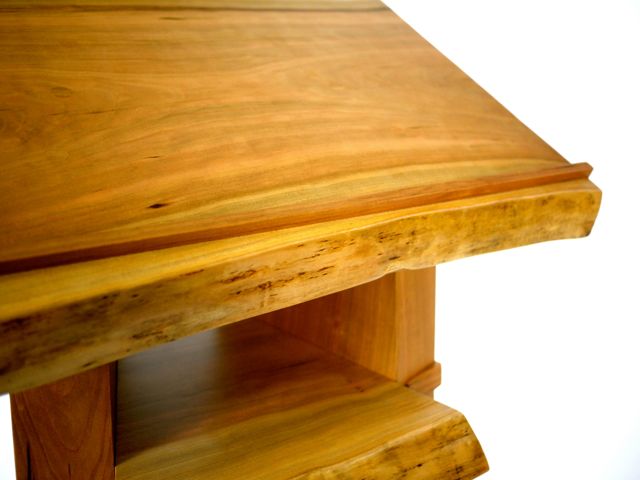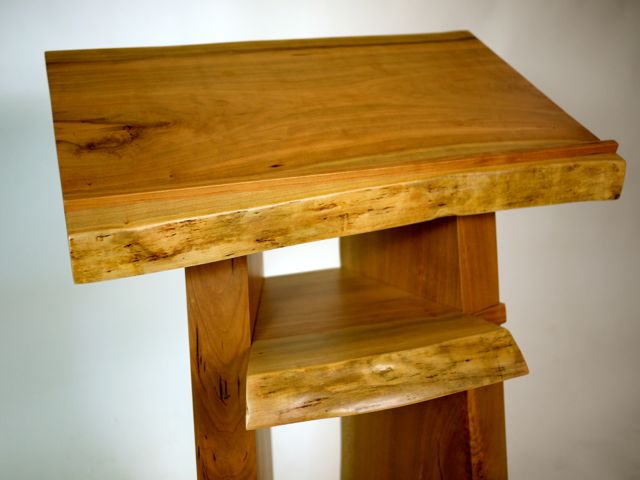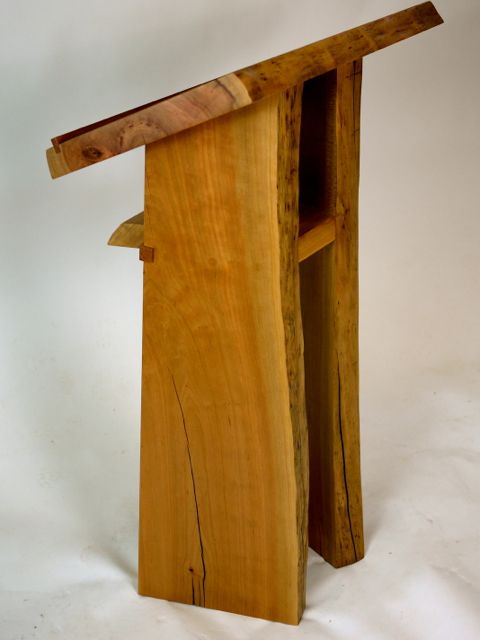
Fox on Neighbor's Roof
There are quite a few fox(es) throughout our outlying communties. I've heard quite odd animal noises for year's, not kowing just what/ where it was coming from. Now I know. I'ts this fox.
A couple of weeks ago we were throwing Frassie some frisbees. It must have startled this fox and it somehow jumped up ontop of the roof of our neighbor's home. Foxes are amazing. So quick, cunning, smart - and now - a leaper!
Split Walnut Bench
This walnut bench is the last piece fresh out of the finishing room last week
Cherry Baptismal Font
This one took a while before the design flowed in. Again, curves aren't my forte'. But I think (hope) we got this one right. I hope to be able to see it in action in the church in Birmingham soon.
Thinking Ovals
Ya, i suppose in some area this ole dog is slow to change. My saws cut, and I seem to have preferences for straight cuts, well at least in the past. Now, after almost seven years of furniture making, i'm actually building my first oval table top. And even more astonishing - i'm enjoying it!
I wiped this unfinished oval tabletop with mineral spirits to "appear" somewhat finished for the pics. In process is this one, and it's mamma.
Dimensions: 64" x 38" 3" thick
Mama: 85" x 47" 3" thick
My plan (for this and future pieces) to build and finish the tops, and allow the customer to choose from completed (or not) legs and heights, and table type.
I'd love to hear what you think about Oval. I'll be sure to post some pics of the completed top, hopefully on some of the leg options before long.
custom solid cherry lectern
This custom order for a church in Birmingham included several pieces. The font and this lectern are the two more unusual and significant pieces of the group.
Coming Soon!
For month's we've been working on "Our Store" - our new online shopping "destination" for our "sophisticated yet grounded" hardwood furniture. We are getting there, making progress every day - stay tuned!
Project update
I'm so far behind on my blog posts, and have pics of several new pieces. Here are pics of most of the projects that we've been working on over the past couple months or so. As you can see, the slow studio's been unusually busy for this time of year. Actually, almost too fast if you ask me. Now, my accountant might disagree.
Our New York based Web Site Platform is Flooding and going down!
I just received notice from our Super everything New York based Web platform Squarespace, that their building is flooding, and all SS sites will temporarily be going down. My gosh. THis is a first. But, I'm sure we can handle it. Please stay tuned, and as soon as SS can they'll have us back online.
I LOVE this Squarespace Web Environment. Hope you are enjoying it as well. Without question, this will not hinder my appreciation and dedication to what I believe to be the best web 2.0 environment on the planet.
Stay Safe our SUPER talented, SUPER creative NY friends at Squarespace!!
Royal Passing - a poem
by: Sheila Taylor
In late October of two thousand and eleven
An ancient Oak Queen left us for tree heaven
This tall beautiful Empress that toward the sky
Now stands lifeless, but one day had to die
No one is quite sure how long she survived
But for hundreds of years she did flourish and thrive
Estimated at five hundred years old, maybe even eight
No matter which number, her life was quite great
he width of her trunk, enormously round
And her branches stretched out to form a beautiful crown
Her feature in an issue of National Geographic
Brought two score and 17 years of noble traffic
How many years did this Bur Oak Queen reign
This beautiful Queen, in no way a plain Jane
She existing on American soil for so many years
That some people now visit and even shed tears
Before Columbus, Washington, World War I or II
Before the Wright brothers, Apollo 11 or the challenger flew
Before Lincoln, Roosevelt or Vietnam
Before Kennedy, King, or the atom bomb
Before the attack on Pearl Harbor or September 11
But we knew someday she had to leave us for heaven
It is not yet known why she took her last breath
And for now she stands lifeless, beautiful even in death
A History Of Wooden Canvases
by: Robert-Phillip Bazoiu
Painted furniture was born out of the necessity to decorate a piece of furniture without having to resort to sculpture, quality wood, or wood that was too expensive for most people. Painted furniture can be traced all the way back to the 16th century in most of Europe starting with Sweden, Switzerland, England, Normandy, Southern Germany, Austria, Poland, Slovakia, Hungary, to Transylvania, Russia and the Baltic countries.
Most northern countries’ motifs were rustic: stylized flowers, countryside homes around a church, crudely-painted farm animals, but northern Europeans also used motifs directly inspired from the French 18th century and Italian baroque Rococo's. The designs painted on 19th century English furniture was famously influenced by the time’s Victorian gardens: furniture covered in delicate contours detached on a sober or clear background. In Normandy, which produced in the 17th and 19th centuries numerous painted trunks and chests used for transporting fine fabrics or jewelry to the East, the most common motifs were the tulip, the rose, lengthened leaves and birds as a symbol of marriage, all on mostly sober backgrounds.
Italy, under the influence of its neighbors from Alsace, developed a certain style of painted furniture that included an elevated type of ornamentation for the rich and for clerics. The trunks had a perspective architectural finish. After a period such painted trunks were no longer fashionable, but painted furniture made a comeback in the 18th century with roses, wreaths, or landscapes that decorated dressers, closets, or harpsichords.
Germany adopted the unique and charming design of the Tölz Rose. Native to northern Bavaria, this little round rose curved around itself is displayed as wreaths or bouquets in vases.
Hungary’s and Poland’s signature design was achieved through the richness of the decor, charm of its colors, and the forms' originality. To furniture painters of this region empty space was the enemy of design. All the surface was covered in a dense manner: isolated flowers or bouquets, twin birds with geometrical shapes, precise design, often miniatures, with a more eastern than Slavic character. In Transylvania, painted furniture was brought by the Transylvanian Saxons who colonized the region and, having the dense, intricate design of Hungarian furniture, was very similar to that of southern Germany.
Roses and tulips were the flowers most favored by European history’s furniture painters. The tulip, symbolizing fertility through its closing form, commonly graced dowry chests. Bouquets and wreaths were rich in flowers more or less stylized, making for an absolutely charming polychromy.
Reference picture: http://stejarmasiv.ro/wp-content/uploads/2012/04/Mobila-pictata-Targul-mesterilor-populari-din-Sibiu.jpg, credits going out to http://stejarmasiv.ro
Our Planet’s Largest Living Tree - a poem
by: Sheila Taylor
General Sherman
General Sherman?
General Sherman?
Who in the world is he?
The General is by volume earth’s largest living tree!
Is this an American General?
Where do this General stay?
Why yes this is an American General who lives in the USA!
How big is the General?
Does he really deserve this rank?
He’s about 300 feet tall and can withstand the hit of a tank!
Okay this General is tall, and a tank?
Is he that sound?
Yes indeed he is, this General is over 100 feet round!
Can you tell me more about him, where can I see his bark?
He stands in a Giant Forest in Sequoia National Park.
A few years ago he lost a branch that was over 8 feet long.
That did not change his status, he still stands just as strong.
If you can come out to see him, you would not believe what you see!
It is amazing to stand gazing at earth’s largest living tree!
Artisan Works at Kew Gardens


David Nash @ Kew Gardens
by Dana Stoll
For the first time in over a decade, wood artist David Nash can be found “mining” sustainably sourced wood at his quarry in the Royal Botanic Gardens at Kew. World renowned for their research and conservation efforts, Kew Gardens seems the perfect backdrop to host an exhibit by the prolific sculptor. It is a deeply-embedded concern for the environment and for the appreciation of nature that unites the two and resonates in everything they do. Nash’s own method is environmentally-minded and in alignment with RWF’s “Respect the Tree” philosophy. In his wood quarry at Kew, Nash mines trees made available naturally through storms or disease. One tree, for instance, was killed by an infestation of beetles. Signs posted all around the exhibit inform the visitor that these trees have reached the end of their natural life, they were not harvested for the sake of art. Utilizing wood that has been sustainably sourced is an integral part of Nash’s creative method, and his long career working with this medium has enabled him to gain a special appreciation of trees.
As an artisan, Nash does not impose his will upon the wood; rather, he views the sculpting process as a synergistic collaboration between the tree and the artisan – one in which he listens to the wood, and lets it speak. In viewing Nash’s sculptures strewn throughout the glasshouse gardens of the Temperate House, it was the imperfections of the wood – the cracks, the warping, the knots – that speak the strongest. Nestled in and among the plants and trees, Nash’s natural art, in the splendor of its flawed beauty, is enhanced by the contrast with the perfection of nature itself.
Artisan Works at Kew Gardens
A Tree Talks
by Richard Harris
Everybody has an opinion on Nature. But what about Nature’s opinion?
EOS magazine decided to give Nature the means to talk.
A 100 year old tree, living on the edge of Brussels, was hooked up to a fine dust meter, ozone meter, light meter, weather station webcam and microphone. This equipment constantly measures the tree’s living circumstances. And translates this information into human language. Then, the tree lets the world know how he feels. Follow the life of the talking tree via YouTube, Flickr and Soundcloud. And friend him on Facebook.
Click here to go to the tree's blog.
Click here to see a "making of" video.
A Tree Talks
Greener Streets - Brussels











by Richard Harris
The pedestrian only area around the historical core of Brussels has just been doubled in size. The actual core had been pedestrian only for years and a nearby shopping area was also. Now they have been joined so that the whole network of medieval streets is now off limits to vehicles.
The work took many months to the intense frustration of the local merchants, the shoppers and the tourists. To celebrate the completion the city threw a daylong party and even invited extraterrestrials. Now, the Unesco World Heritage site that is the Grand' Place and its surroundings is a pedestrian's paradise.
Greener Streets - Brussels
The Responsible Company, a how to guide for responsible businesses
by Kiersen Nichols
In a time of environmental and economic crisis Yvon Chouinard and Vincent Stanley have created a light of practicality, clarity, and hope with their new book “The Responsible Company”. The seasoned mountain man and Patagonia founder Yvon along with company vice president Vincent took the stage at the Yale Center for business to speak about facing the limits of the economy and maintaining a thriving business while being cognizant of environmental factors. Together, the two brought forth the overall message of simplicity, quality, and knowledge.
- The duo explained the book as a ‘how to’ guide for responsible businesses. This idea came from a grassroots creation called Napa Green which outlined actions of sustainability wineries and vineyards could be taking. These actions manifested in a checklist; should a grower or producer meet a given percentage of sustainable requirements they receive a Napa Green certification. “The Responsible Company” comes with a similar checklist for companies and businesses. This checklist reminds companies of the actions they can be taking and also ignites an interest in finding more ways to be environmentally conscious. With this comes the understanding of not just the product itself, but what the product produces. The two men emphasized the waste products of production; how much water is used, where that water came from, etc. Knowing these things are what makes for a responsible business.
Surviving in an economic downturn while remaining kind to the environment is not as hard as one would think, according to Yvon. During a recession people are less frivolous, they want practical products that are functional and made to last. Yvon stated that he believed that any trouble in business or question in business can be answered by increasing the quality of the product.
In the United States the production line has been completely removed. There is little knowledge of where and how products are produced. Yvon expressed adoration for small scale, labor intensive work that employs more people in meaningful jobs. By doing this one not only creates a better product but they help the economy.
The simplest answer, he says, is normally the correct one, and right now most companies involved in large scale production are overly complicated. Vincent Stanley added that large scale production requires less knowledge and less effort; it also requires less jobs and a more poorly created product.
Mr. Stanley pointed out that in the future, for a business to survive with the ecological limitations we will face or exceed, the manager must have a better understanding of his/her operation, more knowledge about his trade. This idea was relayed back from an environmentalist side - that businesses need to learn from nature rather than actively acting against it. Nature loves diversity, hates mono culture and that is how a successful business must be run - without conglomeration.
The conversations of business and conservation were nothing short of philosophical. It is amazing what Patagonia has been able to achieve through taking risks and being vigilant. Care for quality and ethical treatment has led to an inspirational and successful company.
In the end Yvon admitted that running a responsible company can be “a pain in the ass”; however, it is the business owners duty to the consumer and the environment to ensure that sustainable and healthy practices are followed.
The Responsible Company, a how to guide for responsible businesses
The Major Oak In Nottingham
by Janine Pounder
The Major Oak
In Nottingham, we don’t just have tales of ethical outlaws, but deep in the heart of Sherwood Forest sits the Major Oak, the oldest and I dare say, the most famous tree in the UK. Steeped in legend, the notorious hiding place of Robin Hood is thought to be over 800 years old. Along with this feat, the Major Oak has also been credited as the largest tree in Britain weighing a staggering 23 tons; with a girth of 33 feet its branches expand 92 feet.
Also known as Quercus Robur, an English or pedunculate oak, its species nurtures the greatest biodiversity of insects than any other plant in Britain, and certainly has an impressive mass.
Originally named the ‘Cockpen Tree’, it was used to hold game birds for cock fighting under the branches. It was renamed in 1790 by Major Hayman Rook, a local antiquarian. Rook wrote a book cataloguing all the oak trees of Sherwood. The tree was titled ‘The Major’s Oak’ before its evolution to its recent name of ‘The Major Oak’.
Whether or not Robin Hood did live inside the trunk will always be an area of debate, but one certainty is that the Major Oak is naturally hollowed by fungi which has slowly eaten away at the bark. Since 1908, conservation measures have been enforced to preserve what has been voted ‘Britain’s favourite tree’ by the National Tree Council. Because of its gargantuan structure the tree has to be supported by wooden beams.
Sherwood Forest is thought to have begun its life some 10,000 years ago at the end of the last Ice Age, and despite much of the forest being felled during the medieval period, much of it has been preserved, giving visitors an insight into what England would have looked like before its landscape was altered by farming. Alongside its award-winning tenant, Sherwood Forest has recently been named a National Nature Reserve by English Nature, an organisation dedicated to conservation and the enhancement of biodiversity.
The forest houses over 1,000 ancient oaks and, being home to rare beetles, bats, fungi and birds, is recognised as an area of scientific interest. This year, the Olympic torch passed through Sherwood and visited the Major Oak as part of its 8,000 mile relay through England. The interest the tree generated in the national media drives home the historical and cultural significance of green spaces, and sends a clear message of how important environmental preservation is to our communities.
When asked to name examples of cultural or historical significance, most people tend to think of man-made structures such as the Lincoln Memorial in Washington, D.C., the Eiffel Tower in Paris, or Big Ben in London.
However, the natural world can provide us with a richer insight into history than any structure created of brick and mortar. A hub of conservation and education, the Major Oak and its surrounding forest are just one of many locations around the world that are important to preserve not just for the environment, but our respective heritage.
References:
Sherwood Forest
Major Oak
Major Oak History
Related Link
I have images of the Major Oak, which have been taken by photographer Breixo Marino. He has granted me permission to use his images. Thanks
The Major Oak In Nottingham
Talking Trees and Dendrochronology
by Ericka Michal
When I was a kid in rural Washington State, I grew up on the property my father was raised on. I heard the stories from my grandparents about how when my father, the seventh of eight children, was a toddler he used to like running off and trying to hide, so they put a red hat on him to be able to spot him on the hundred acres of old-growth timber.
My grandparents came from Slovakia, and were a team in every aspect of the word. When they cut the firewood or lumber, my grandmother and grandfather worked the crosscut saw together—split, stacked, and hauled the finished product to its designated spot.
My dad bought twenty of the hundred acres and the house from his parents, and we had a routine every year as I was growing up: to venture to the swamp and cull the widow-makers and snags for firewood that coming winter. Dad would warm up his Stihl chainsaw after carefully filing the chain to sharpen its teeth, and tell us all to stand back with our safety goggles in place.
Sawdust would fly; the buzz of the chainsaw would fill your ears, and then cut out just before the telling crack of the tree falling. We had the joy of calling “Timber!” as the tree was going down, and resting on the stump as dad came back from checking on the fallen tree. It was one of those times that my dad informed me I was sitting on a map of the tree’s life.
I quickly hopped up and looked around me. He pointed at the tree stump, and at the tree’s freshly cut log end. “Those rings tell you how old a tree is, and what kind of life or environment has happened while it grew.” We counted the rings of the trees after that every year and dendrochronology was a word I became familiar with at seven years of age.
Now, as an anthropology major in college, I have learned more about dendrochronology, and that even the Viking ships that are unearthed, are able to be dated by the tree rings within the slabs or logs on their ships, along with the knowledge of where the tree was likely harvested from and the weather or climate conditions the tree had endured up to the time of its harvest.
People often say, “if trees could talk...” Well, they do. Every tree is unique and has a story to tell, which is why I enjoy looking at the furniture Robin Wade makes, and deciphering what the tree went through before I was able to enjoy its wood in my table, chair, bench, or counter-top. I wonder who sat under its branches many years ago, had their first kiss, shot a bear or deer to feed the family.
Because trees do talk; trees do talk, try listening for yourself.
Talking Trees and Dendrochronology
Seaside Sustainable Living Tour
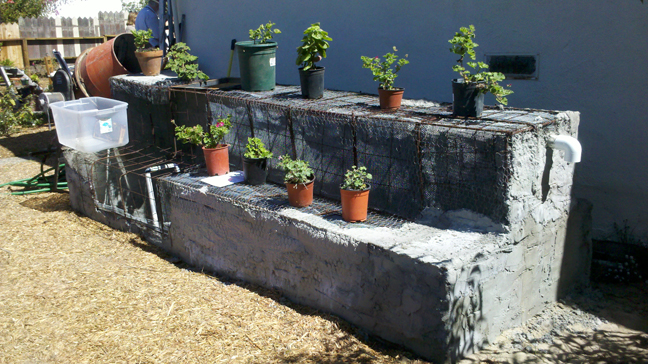

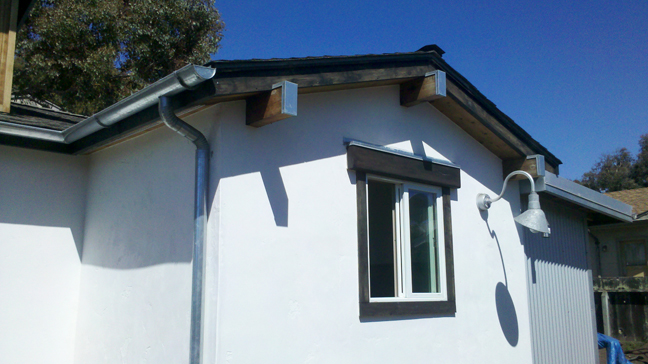
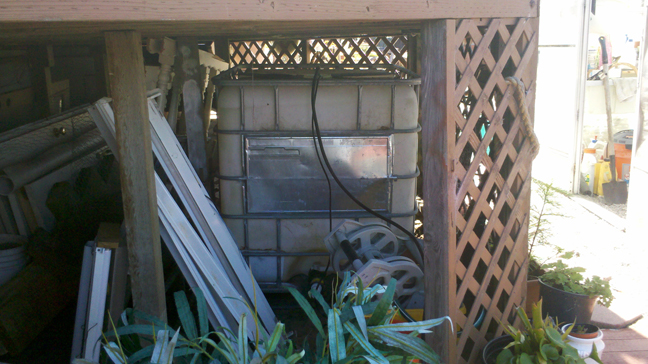
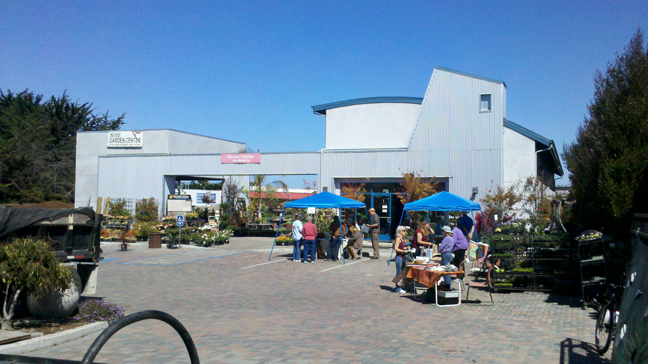

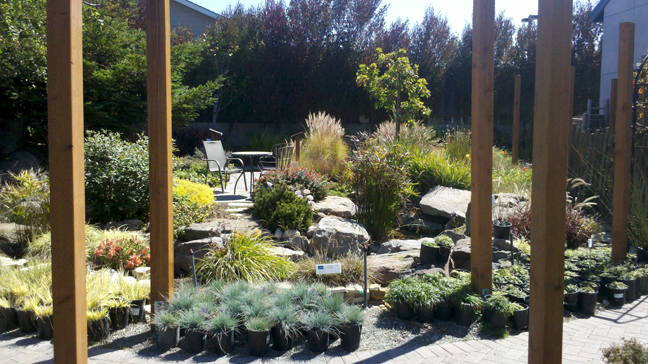

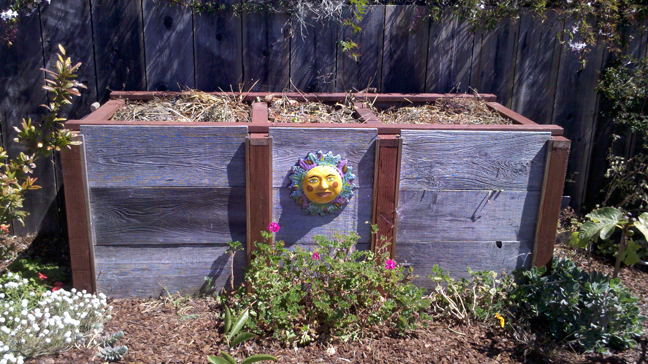
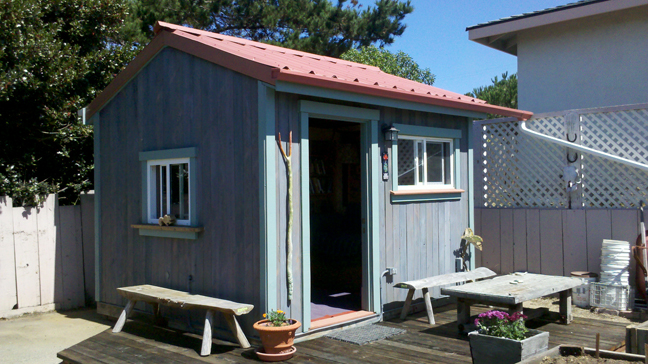

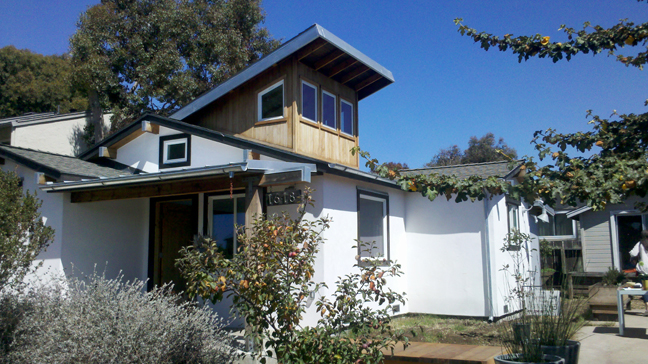
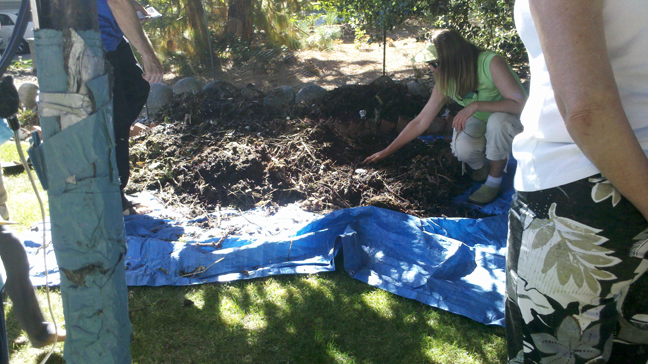
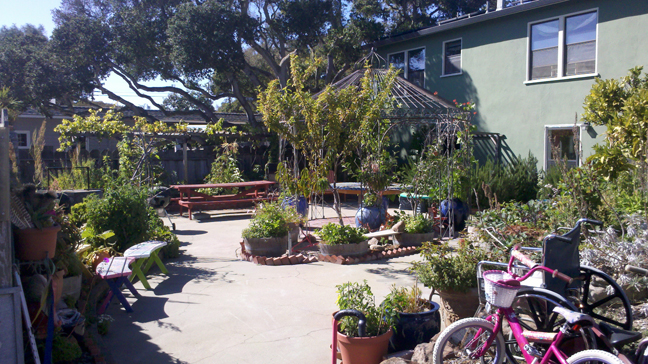
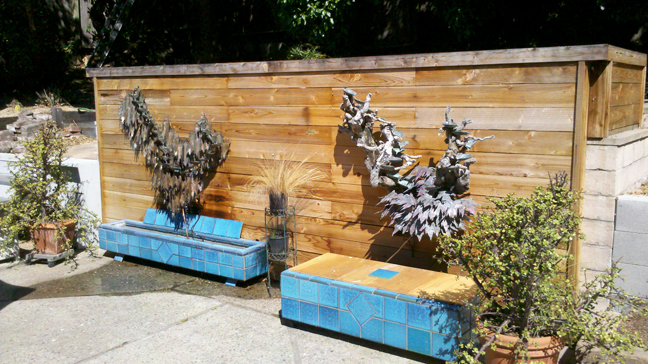

by Brendan Thompson
On Sunday September 9th, the California central coast city of Seaside held its third annual Sustainable Living Tour. Previous tours had focused on sustainably designed homes but this year the focus was more on DIY home improvements made by owners, showing that almost anyone can reduce their living costs and increase their contributions to improving the environment and local community.
The self-guided tour began with registration at the Seaside Garden Center, which specializes in drought-resistant and native plants. The Garden Center also sells various composts and soils for planting as well as tools and equipment. This year the Garden Center also hosted a talk by Jimmy Rogers of Kellogg Garden Products, during which he discussed soil health and beneficial mycorrhiza.
Pictures:
0101 – The tour kicks off at the Seaside Garden Center
0102 – A sampling of some of the Seaside Garden Center's native and hardy plants
At the tour's first home, Tom Hughes and Cathy Rivera showcased a variety of sustainable projects throughout a large backyard – an array of vegetable gardens are pollinated by bees from the ten hives spaced around the property. These vegetable gardens are constructed from Hardieplank siding, whose product is strong, cost-effective, and eliminates some of the warping issues that wood can have. The vegetables are grown in mushroom compost, which is weed-resistant and free except for hauling costs from Salinas Mushroom Inc. or Global Mushrooms. Tomatoes are grown along the south facing wall to take advantage of seasonal sun in this mostly foggy climate. A 3,000 gallon catchment tank captures rainwater from the second floor gutters, and a storage system is under construction that will store up to 5,000 gallons. Almond and fruit trees are watered using greywater diverted from the laundry and bathtub using a branched drain system popularized by Art Ludwig.
Pictures:
0201 – Several of the 10 beehives spaced throughout the backyard
0202 – A rainwater catchment and storage basin is under construction
Home two featured a greenhouse and several catchment tanks, one of which is situated beneath a deck to save space. Walkways made from broken shipping pallets curve from the front yard into the gently sloping backyard and allow easy access to the many vegetable gardens. Recycled gallon milk jars are used as watering cans. The backyard was originally completely neglected and the present owner Marty Davis is currently about halfway through her planting and building process, covering the bare dirt with wood chippings and installing gopher-proof planter boxes.
Pictures:
0301 – Walkways are made from broken shipping pallets
0302 – A rainwater catchment tank is housed underneath a deck
At the third home visitors were greeted with creations by a kindred spirit to our own Robin Wade: woodworking artist Michael Wildgoose creates custom furniture from salvaged wood and he also showed tour participants the homemade shed studio in his backyard. Michael found most of the materials for the shed and his pieces – benches, cabinets, doors and more – by exploring local salvage yards, Monterey Regional Waste Management District's Last Chance Mercantile, Habitat for Humanity's Re Store and Randattzo Enterprises. Since the shed studio is 120 square feet, Michael actually didn't need a permit to build it according to Seaside's building codes. However, it provides plenty of room for a small library, furniture and a work desk. The distinctive slanting cylindrical designs in Michael's furniture are either bamboo or tamarisk, a.k.a. salt cedar.
Pictures:
0401 – Michael Wildgoose creates distinctive furniture with reclaimed materials
0402 – A shed studio in the backyard designed and built by the homeowner
At the tour's fourth home, nestled atop one of Seaside's tallest hills, a tiered garden of succulents and drought-resistant plants frames a spectacular view of Monterey Bay. Louise and Peter Berry enlisted the help of landscape designer Helen Garcia to arrange their plantings, and they set up fruit trees and herb/vegetable gardens just outside their kitchen door. Small gazebos, shade structures and a fire pit made partly from recycled truck parts are spaced comfortably throughout the lush backyard, helping residents and visitors to sink into a relaxation almost immediately. A whimsical sun sculpture adorns a large homemade compost box. During the tour the owners made some of their many plants available for sale, with proceeds going to Sustainable Seaside.
Pictures:
0501 - Succulents and hardy plants frame a spectacular view of Monterey Bay
0502 – A compost bin decorated with a sun sculpture
The fifth home showcased full-scale sustainable construction as well as gardening. Multitalented landscape and architectural designer Tracy Parker has completely renovated a dilapidated house to serve as her own home and studio. Outside, a rainwater flows under a reclaimed redwood deck into a permeable stone basin which feeds native plants and fruit trees. Inside, white walls and a high entryway with south-facing clerestory windows contribute to a welcome cooling effect during the hot summer months. Tracy also created much of the furniture inside and outside the house. She plans to implement a Rainwater HOG catchment system , an innovative modular design that can be stacked in compact spaces and even between joists or beams in buildings and can be used for thermal mass.
Pictures:
0601 – South-facing clerestory windows make the most of seasonal sun
0602 - The designer/homeowner's attention to detail is evident in the structure
At the tour's sixth home, Mary Pat O'Rourke and carpenter Don Basseri make extensive use of rainwater catchment. Two 1,500 gallon tanks serve the backyard and one in the front yard takes care of fruit trees. A network of pipes connects the three pipes to the roof, and a simple switch in the front yard allows control over the water's distribution. The backyard tanks are supported by a wooden enclosure which features two sculptural fountains. The fountains were found at local gardening stores, but the water they are fed with is all captured by the system.
Pictures:
0701 – 1,500 gallon tanks store rainwater and parse it out to the surrounding plants
0702 – The tanks have more than enough water left over to feed two decorative fountains
The tour's seventh and final home played host to several speakers throughout the day – I only caught the tail end of a talk on healthy eating but did manage to hear and see the home's owner, Susan Ragsdale-Cronin, give a demonstration of 'hot' vs. 'cold' composting – hot composting involves weekly turning, whereas cold composting is left alone – the cold method takes longer but provides richer fertilizer. Susan mentioned that a lot of coffee shops will give away their extra grounds, and placing cut-up potatoes in a top layer of compost is a good way to tell when the compost is ready; when the potatoes have grown, the compost is done. Susan then showed the tour participants around her extensive backyard, home to chickens and a wide variety of plants, many of which are 'volunteers' – a stray seed takes hold and she simply lets it grow. Many of the plants are fed with greywater from hand washing her dishes, and she pointed out that a clothes dryer can use more energy than a refrigerator so she dries clothes on the line.
Pictures:
0801 – The homeowner demonstrates the difference between 'hot' and 'cold' composting
0802 – The extensive and beautiful backyard is largely fed with greywater
This year's tour provided a glimpse into some of the simple and cost-effective ways ordinary people can green their homes or even apartments, and next year I hope to revisit some of these homes and see how they progress!

















